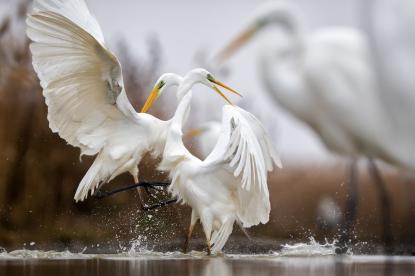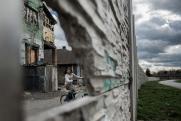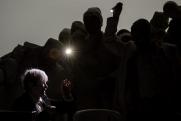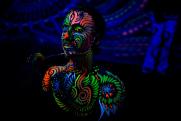2024. April 28. Sunday
- Budapest
|
|
Address: 1065, Budapest Nagymező utca 8.
|
The exhibition has closed for visitors.
2015.03.20. - 2015.05.23.
I have been long interested in the issue of press photo metamorphosis. Naturally, you do not have to think of something very deep, philosophical or artistic. It is only about the journey the pictures take between the time of the annual competition jurying and the opening of the exhibition.

Most of the time, photographers upload works from the previous year or pictures correspondent to everyday, current events. Images the function of which is mainly to inform the readers visually (also) and provide them more information about the events. As such press photo is not a work of art because, along with the daily newspaper, most cases will soon end up in the trash Rolling Stones said that decades ago::
Who wants yesterday's papersWho wants yesterday's girlWho wants yesterday's papersNobody in the world
Nobody is interested in what happened yesterday
So apparently a good press photo's only task is to inform according to local value, on given surface, appearing in columns, in accordance with the original meaning of the word :report..
Of course, we are aware of countless examples of a press photo becoming a powerful artistic work of art. I think, however, that this process takes years or decades and contribute to, among other things to changes in circumstances, the passage of time, intensification of documentary value. I find it natural that these pictures had travelled this journey and I feel that it does cause them some identity issues when they need to become a work of art in a very short time, in this case 1-2 months from the jurying to the opening of the exhibition.
Press photo genre will soon be hundred years of age. It is an everyday genre - I deliberately do not say art. It is independent enough to appear individually on the walls of museums and galleries without having to use the attributes of other genres to be shown.
Seeing the widespread of commercial television and the Internet, many envisioned the end of the Gutenberg galaxy. Then it turned out that there is no way that the printed books will disappear from our lives. Very successful businesses and services during the last 1-2 decades, eg.g Amazon, show that the Internet is not the enemy, and can also assist in selling of books.
However, it might be that other rules apply to newspapers, dailies, that is, to the main surface of press photos. The surface on which material is printed gets narrower and narrower day by day, so that the images will be able to appear less and less in their original printed form. We almost do not see the image reports that give emphasis, accent to the pictures..
All this, if not remedied, we hope is evoked by this year's press photo exhibition. We attempted to show the pictures in their original, natural environment, the most possible similar environment.
Tamás Szigeti
The exhibition was organized by: the photographer Tamás Szigeti , secretary for the Photo Reporters Department of MÚOSZ.
Artists: Orsolya Ajpek, Attila Balázs, Balázs Béli, Zoltán Bese, István Bielik, Lajos Bíró, János Bődey, Krisztián Bódis, Tamás Botos, Thomas Campean, Gyula Csernok, Sándor Csudai, Zsolt Czeglédi, Gyula Czimbal, István Derenycsényi, Miklós Déri, Dániel Dömölky, Dr. József Borsi , Dr. Csaba Mészáros, Zsolt Eöri Szabó, Gábor Erdélyi, Csaba Faragó, István Fazekas, Bertalan Fehér, Balázs Gémesi, József Gergely, Miklós Gódor, András Hajdú D., Norbert Hartyányi, Róbert Hegedűs, Bálint Hirling, István Huszti, Tibor Illyés, Tamás Janzsó, Márton Kállai, Péter Kálló, Bea Kallos, Norbert Kaszás,Péter Komka, Szilárd Koszticsák, Tamás Kovács, Zita Kovács, Csaba Krizsán, Árpád Kurucz, Benedek Lakatos, János M. Schmidt , Bence Máté, Balázs Mohai, Simon Móricz-Sabján, László Mudra, András Péter Németh, Gergely Máté Oláh, Zsófia Pályi, Márta Pintér, Roland László Pozsonyi, Tünde Rácz, Zsuzsanna Sándor Tóth, István Csaba Sánta, Dániel Selmeczi, Ákos Stiller, Áron Süveg, Balázs Szabó, Gábor Szabó, Péter Szalmás, Bence Szemerey, Zsolt Szigetváry, László Szirtesi, Miklós Teknős, Csaba Tökölyi, Márton Tordai, László Tóth, Zoltán Tuba, Ádám Urbán, Tamás Varga, László Végh, Viktor Veres, Bálint Vincze

Most of the time, photographers upload works from the previous year or pictures correspondent to everyday, current events. Images the function of which is mainly to inform the readers visually (also) and provide them more information about the events. As such press photo is not a work of art because, along with the daily newspaper, most cases will soon end up in the trash Rolling Stones said that decades ago::
Who wants yesterday's papersWho wants yesterday's girlWho wants yesterday's papersNobody in the world
Nobody is interested in what happened yesterday
So apparently a good press photo's only task is to inform according to local value, on given surface, appearing in columns, in accordance with the original meaning of the word :report..
Of course, we are aware of countless examples of a press photo becoming a powerful artistic work of art. I think, however, that this process takes years or decades and contribute to, among other things to changes in circumstances, the passage of time, intensification of documentary value. I find it natural that these pictures had travelled this journey and I feel that it does cause them some identity issues when they need to become a work of art in a very short time, in this case 1-2 months from the jurying to the opening of the exhibition.
Press photo genre will soon be hundred years of age. It is an everyday genre - I deliberately do not say art. It is independent enough to appear individually on the walls of museums and galleries without having to use the attributes of other genres to be shown.
Seeing the widespread of commercial television and the Internet, many envisioned the end of the Gutenberg galaxy. Then it turned out that there is no way that the printed books will disappear from our lives. Very successful businesses and services during the last 1-2 decades, eg.g Amazon, show that the Internet is not the enemy, and can also assist in selling of books.
However, it might be that other rules apply to newspapers, dailies, that is, to the main surface of press photos. The surface on which material is printed gets narrower and narrower day by day, so that the images will be able to appear less and less in their original printed form. We almost do not see the image reports that give emphasis, accent to the pictures..
All this, if not remedied, we hope is evoked by this year's press photo exhibition. We attempted to show the pictures in their original, natural environment, the most possible similar environment.
Tamás Szigeti
The exhibition was organized by: the photographer Tamás Szigeti , secretary for the Photo Reporters Department of MÚOSZ.
Artists: Orsolya Ajpek, Attila Balázs, Balázs Béli, Zoltán Bese, István Bielik, Lajos Bíró, János Bődey, Krisztián Bódis, Tamás Botos, Thomas Campean, Gyula Csernok, Sándor Csudai, Zsolt Czeglédi, Gyula Czimbal, István Derenycsényi, Miklós Déri, Dániel Dömölky, Dr. József Borsi , Dr. Csaba Mészáros, Zsolt Eöri Szabó, Gábor Erdélyi, Csaba Faragó, István Fazekas, Bertalan Fehér, Balázs Gémesi, József Gergely, Miklós Gódor, András Hajdú D., Norbert Hartyányi, Róbert Hegedűs, Bálint Hirling, István Huszti, Tibor Illyés, Tamás Janzsó, Márton Kállai, Péter Kálló, Bea Kallos, Norbert Kaszás,Péter Komka, Szilárd Koszticsák, Tamás Kovács, Zita Kovács, Csaba Krizsán, Árpád Kurucz, Benedek Lakatos, János M. Schmidt , Bence Máté, Balázs Mohai, Simon Móricz-Sabján, László Mudra, András Péter Németh, Gergely Máté Oláh, Zsófia Pályi, Márta Pintér, Roland László Pozsonyi, Tünde Rácz, Zsuzsanna Sándor Tóth, István Csaba Sánta, Dániel Selmeczi, Ákos Stiller, Áron Süveg, Balázs Szabó, Gábor Szabó, Péter Szalmás, Bence Szemerey, Zsolt Szigetváry, László Szirtesi, Miklós Teknős, Csaba Tökölyi, Márton Tordai, László Tóth, Zoltán Tuba, Ádám Urbán, Tamás Varga, László Végh, Viktor Veres, Bálint Vincze



